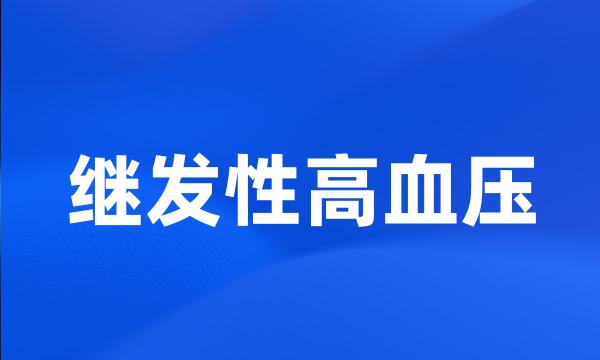继发性高血压
- 名secondary hypertension
 继发性高血压
继发性高血压-
本文对各型继发性高血压和正常人的血浆儿茶酚胺及P物质进行了铡定。
Determination of serum catecholamine ( CA ) and substance P ( SP ) on patients with secondary hypertension and normal controls were carried out in our research .
-
排除标准:甲亢、继发性高血压、感染、心肌梗死、NYHAⅡ级以上心力衰竭、心律失常、糖尿病、糖尿病酮症酸中毒、高渗性昏迷病史。
Exclusion criteria : hyperthyroidism , secondary hypertension , infection , myocardial infarction , NYHA class II and above , heart failure , arrhythmia , Diabetes Mellitus . Methods : 1 .
-
背景和目的肾实质性高血压是最常见的继发性高血压。
Background and objective Renal hypertension is very frequent in secondary hypertension .
-
儿童继发性高血压以急性肾小球肾炎引起多见。
Acute glomerulonephritis is a major cause of childhood secondary hypertension . 3 .
-
夜间血压降低幅度的减少和持续夜间高血压是继发性高血压的特有标志
Reduced nocturnal blood pressure dip and sustained nighttime hypertension are specific markers of secondary hypertension
-
继发性高血压的诊断及鉴别诊断
Diagnosis and Antidiastole on Secondary Hypertension
-
结果降压失败原因分析:①继发性高血压2例;
Results The analysis of defeat reason about dropping blood pressure : ① Sequential hypertension 2 cases ;
-
继发性高血压分子遗传学进展
Molecular genetics in secondary hypertension
-
肾性高血压是继发性高血压最主要的原因,占高血压总数约10%,在临床治疗中较原发性高血压常更难以控制。
Renal hypertension is the mean reason of secondary hypertension , which accoutered for 10 % of hypertension .
-
原发性高血压患者血清总胆汁酸值较继发性高血压及对照组均明显升高(P<0.01)。
No significant difference was found in TBA levels between secondary hypertensive and control group ( P > 0.05 ) .
-
这可能就是为什么高血压时间越长、继发性高血压手术使血压恢复正常的可能性越小的原因。
This may be why the longer hypertension has existed , the less likely surgery for secondary causes will restore BP to normal .
-
在继发性高血压中,内分泌性高血压占51·3%,肾血管性高血压占24·8%;肾性高血压占22·3%。
Secondary hypertension comprised 51.3 % of endocrine hypertension , 24.8 % of renovascular hypertension ( RVH ) and 22.3 % of renal hypertension .
-
结论:1.儿童继发性高血压病因在不同年龄段有所差异,其临床症状因原发病不同而相差甚多。
The etiologies of secondary hypertension in children vary with their ages , the clinical presentations are also different because of their primary diseases . 2 .
-
原发性醛固酮增多症是最常见的导致继发性高血压的病因之一,在高血压人群中发病率高达10%~18%。
Primary aldosteronism is one of the commonest form of secondary hypertension with an approximate prevalence of 10 % ~ 18 % in the patients with hypertension .
-
结果继发性高血压患者血清总胆汁酸值和对照组比较无差异(P>0.05);
Results There was a significant increase of TBA in essential hypertensive group compared with that of control group and secondary hypertension ( P < 0.01 ) .
-
方法酶法检测30例健康人、21例继发性高血压及76例原发性高血压患者血清总胆汁酸并进行比较。
Methods The concentration of serum TBA was measured by enzymatic method in 127 cases including 30 healthy controls , 21 secondary hypertensive patients and 76 essential hypertensive patients .
-
所有病例均根据病史、体检及实验室检查排除症状性高血压、继发性高血压、肝功能异常、肾功能不全。
On the basis of history of illness , physical examination and laboratory check , all cases exclude symptomatic hypertension , secondary hypertension , abnormal liver function and renal insufficiency .
-
继发性高血压是由疾病引起的,如充血性心力衰竭、肾衰、肝衰或内分泌(激素)系统受损。
Secondary hypertension is caused by a preexisting medical condition such as congestive heart failure , kidney failure , liver failure , or damage to the endocrine ( hormone ) system .
-
所有患者均排除继发性高血压、糖尿病、甲状腺功能减退症、感染性疾病、风湿性疾病、肿瘤性疾病以及严重心、肝、肾功能不全,还包括急性心肌梗死患者。
There are no subjects with the secondary hypertension , diabetes mellitus , hypothyroidism , infection , rheumatism , tumor and serious heart , liver and renal insufficiency , and acute myocardial infarction .
-
经过询问病史、体检、实验室和心电图检查排除继发性高血压、心脏瓣膜病、糖尿病、甲亢、外周血管病、肝肾功能障碍等疾病。
They were excluded from non-essential hypertension , valvular heart disease , diabetes , hyperthyroidism , entourage vein disease , liver and kidney function obstruction according to illness history , body check , laboratory and cardiogram .
